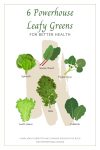How often do you eat dark leafy greens?
That was the question my eye doctor asked when I went to my last eye appointment.
As much as I enjoy leafy greens, I had to be honest and say, “Not often.”
His response was, “Well, you should be eating them daily.”
My family has a horrible history of eye disease. I’ve made sure my children’s eyes were checked annually, and thankfully, they have continued to do so and make sure their children’s eyes are checked. I regularly have my eyes checked, but I wasn’t proactive in taking care of my eyes through my diet.
It’s not fun waiting for the outcome of your eye exam to see if any signs of eye disease is apparent. A couple of years age my eyes began showing the first signs and then cataracts appeared.
Growing older is not fun, especially when your eyes are involved.
I’ve taken his advice, and now eat my super greens daily.
And that’s the key – eating healthy nutritional leafy greens.
Are you aware that not all leafy greens are beneficial when it comes to their nutritional value?
As I’ve researched the best leafy greens for my eye health, I choose to eat only those greens that will provide me with the best nutritional value.
You may wonder why my eye doctor recommended leafy greens over a supplement.
Leafy Greens are your nutritional powerhouse.
Dark leafy greens are considered a superfood due to their high content of vitamins and minerals. The darker the better. Plus, you’ll get a daily dose of antioxidants to fight those free radicals that attack your body, and eyes, every day. You’ll get a healthy dose of folate, vitamin K and A, and plenty of fiber, which improves your gut health.
Here are my favorite dark leafy greens that are priority in my kitchen and how I prepare them.
Leafy Spinach
Spinach is an easy green to grow yourself. You plant the seeds in early spring and enjoy until the summer heat arrives. Then you can plant in late summer for a fall harvest. This allows you to enjoy fresh spinach for about six months of the year.
Have you cut back on eating meat? Well, spinach is a great alternative. You’ll benefit from this superfood by adding folate, potassium, vitamin A, and other B vitamins to your diet.
Spinach is great raw or lightly steamed. Use spinach in your salads, add to your breakfast or morning snack smoothie, light sauté with fresh crushed garlic and seared grape tomatoes for your evening side dish.
Fiber Rich Swiss Chard
Swiss chard, packed with loads of fiber, antioxidants, vitamins K, A, and C, minerals such as magnesium, iron, and potassium, and should be a staple in your weekly meal planning. Like other dark leafy greens, you can serve this as a side dish with any meal.
Sauté Swiss chard with fresh crushed garlic in a little olive oil. Add it to your soups and stews during the fall and winter. Make Swiss chard chips by rubbing the leaves with a little olive oil and sprinkle with Himalayan pink salt or Sea salt, then bake until crispy. Stuff chicken breast with Swiss chard and goat cheese and bake.
Peppery Flavor Watercress
This dark leafy green is so powerful that it has its own website. That should tell us something about the benefits of adding watercress to our meal planning.
Watercress has a peppery flavor and will add a little kick to any dish. You can eat it raw in your salads, add to your sandwiches rather than lettuce, drop you’re your fall and winter soups for added flavor, add to your smoothies, and lightly sauté in olive oil, then sprinkle with parmesan cheese for a side dish.
Tasty Leaf Lettuce
Not only did I plant spinach this year, I planted oak leaf and red leaf lettuce.
It was so much fun to go out to the garden each day and pick my lunch. I also planted celery and green onions for added taste. I’ll plant a fall crop in September to enjoy during the fall and winter months.
Leaf lettuce provides you with plenty of folate, vitamin A, manganese, iron, and are full of different antioxidants. Plus, leaf lettuce hydrates your body. Add leaf lettuce to your sandwiches and wraps, build your salad with leaf lettuce and spinach for added superfood power. If you make your own wraps, add chopped leaf lettuce to your dough. Skip the flour wraps and use the leaves as your wrap.
Crunchy Kale
Cute story: One Thanksgiving my daughter made Kale chips for our Thanksgiving family dinner. We always have appetizers, and we were trying to skip the heavy unhealthy appetizers and made our own “healthy” appetizers for just her and me. We assumed that no one would eat our appetizers because they were different and healthy. After everyone arrived and I was in the kitchen putting the final touches on our banquet, she bounded in exclaiming, “they’re eating all of our appetizers!” The Kale chips were gone!
Kale is a member of the cabbage family and provides you with a wealth of vitamins such as A, K, C, and B6, and the minerals manganese, and copper.
Use kale in your salad – baby kale only, add to your fall and winter soups, steam or roast, adding your favorite herb or spice and crushed fresh garlic for a flavorful side dish. And of course, kale chips. Brush the leaves with a little olive oil, sprinkle with Himalayan salt or Sea salt, bake until crispy.
Here’s a Kale salad recipe to add to your weekly meal plan:
Citrusy Cauliflower Kale Summer Salad
Southern Collard Greens
I’m not sure how I raised southern children that refuse to eat collard greens. A staple in every true southern home, this is my favorite dark leafy green. You do not begin the New Year without a pan of collard greens on your stove.
As part of the cabbage family and related to kale, collards are high in fiber and a great source of vitamin K, A, and C. Collards can be steamed, blanched, or sautéed. My favorite way to prepare collards is to sauté in olive oil and sprinkle with red pepper flakes while cooking.
These are my favorite super greens that I prepare regularly. My goal is to keep my eyes as healthy as I can, and eating dark leafy greens is the best natural way to do this.
Download this pantry printable chart to remind you which super greens to add to your weekly meal planning.




